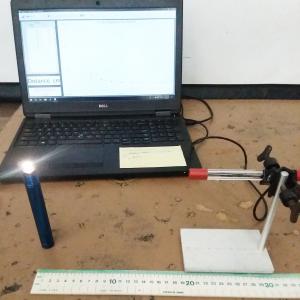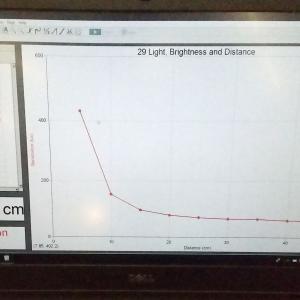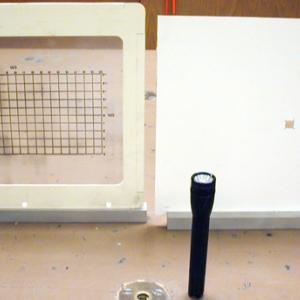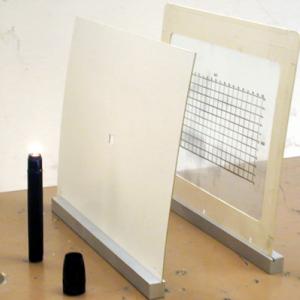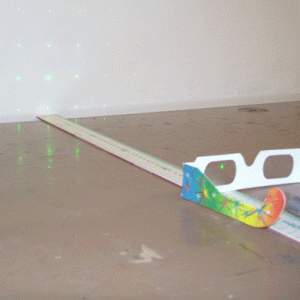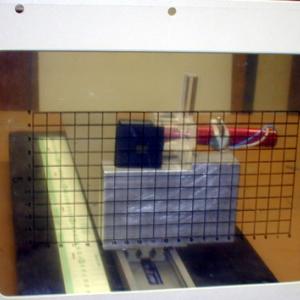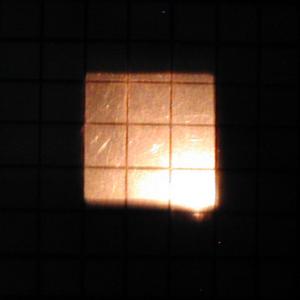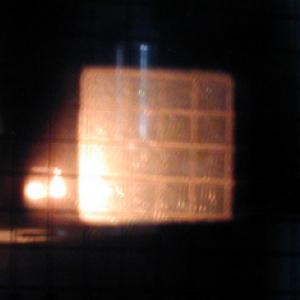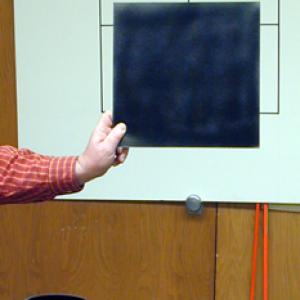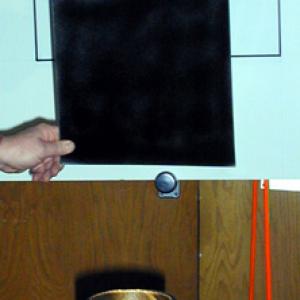College of Liberal Arts & Sciences
6B10.10 - Inverse Square Law - Point Source
Unscrew the focusing cap from the maglite and set it at the 0 cm position of the meter stick. Start with the light sensor at the 10 cm mark and plot your first point. Move back at 5 cm intervals as you plot the rest of the points. In inverse square graph will be recorded and curve fitting may be applied.
The Maglight setup is a smaller version of that mentioned above and is intended for individual viewing or lab work. Instead of 1 foot square cardboard we are using a 1 cm square mask.
The Maglight set up on the translational stage and railing is a more automated version of the simple Maglight demo also using the 1 cm square mask. This is primarily intended to be used in the classroom with a video camera looking at the grid.
NOTE: The camera must be positioned so that it is not directly inline with the Maglight and the masking hole.
Although not shown in the pictures above the overhead projector can also be used to show inverse square. Move the projector very close to a screen and turn on and measure the area illuminated. Move the projector back twice as far and again measure the area illuminated. Continue for 3Xs the distance and 4Xs the distance and the are should increase for all of these according to the inverse square model.
Another simple way to do this is to use a laser pointer, meter stick, and a pair of the 2 D diffraction glasses we use for outreach. You will get a square pattern of dots that will expand as you move the glasses/diffraction grating from 25 to 50 to 75 to 1 meter on the meter stick.
Use a 100 W light bulb as a pinpoint source. To do this align the filament so that its long axis is perpendicular to the large white board. Once aligned set the masking tube over the light bulb to enhance viewer observation. Holding the single one foot square at distance 1 from the light bulb show that it only covers one square of the large grid boards. Move the large grid board back to 2X the distance and show the shadow now covers 4 squares. Repeat by moving the board back to 3X and 4X the distance and show that the shadow now covers 9 and 16 squares respectively.
- Robert De La Cruz, Angela M. Kelly, "Exploring Illumination and the Inverse-Square Law with Arduino", TPT, Vol. 62, #6, Sept. 2024, p. 527.
- James C. Sanders, Victoria C. Colvin, Soumitra Ganguly, Caroline E. Howell, Ernest Sebastian Lee, Suraj Thapa Magar, Nicholas A. Johnson, "Adherence to and Deviation from the Inverse-Square Law of Intensity for Sound and Light", TPT, Vol. 61, #5, May 2023, p. 374.
- Pangratios Papacosta, Nathan Linscheid, "The Confirmation of the Inverse Square Law Using Diffraction Gratings", TPT, Vol. 52, # 4, April 2014, p. 243.
- Alan Bates, "The Inverse-Square Law with Data Loggers", TPT, Vol. 51, # 5, May 2013, p. 290.
- "Figuring Physics", TPT, Vol. 49, # 3, March 2011, p. 134.
- Russell Downie, "A Data Analysis for the Inverse Square Law",TPT, Vol. 45, # 4, April 2007, p. 206.
- Pietro Ferraro, "Speckle Noise or Dust Diffraction", TPT, Vol. 37, # 6, Sept. 1999, p. 324.
- V. Anantha Narayanan, Radha Narayanan, "Inverse-Square Law of Light with Airy's Disk", TPT, Vol. 37, # 1, Jan 1999, p. 8.
- Iona, Mario, "Proper Graph Scales", TPT, Vol. 37, # 4, April 1999, p. 195.
- Simon George and Robert Doebler, "Rainbow Classes and the Inverse-Square Law", TPT, Vol. 32, # 2, Feb. 1994, p. 110.
- Thomas T. Arny, "Demonstrating Atmospheric Diffraction Rings with a Tensor Lamp", AJP, 55, # 1, January 1987.
- F.J. Wunderlich, D. E. Shaw, and M. J. Hones, "A Light-Emitting Diode as a Point Light Source", AJP, Vol. 45, #1, Jan. 1977, p. 106.
- Haym Kruglak, "Laboratory Exercise on The Inverse Square Law", AJP, Vol. 43, # 5, May 1975, p. 449.
- George M. Hopkins, "Intensity of Light", Experimental Science, p. 222.
- John Henry Pepper, Henry George Hine, The Boy's Playbook of Science, p. 13.
- David Kutliroff, "1, Demonstrating the Inverse Square Law for Light with a Shadow Photometer", 101 Classroom Demonstrations and Experiments For Teaching Physics, p. 17.
- Yaakov Kraftmakher, "1.17, Photometric Laws", Experiments and Demonstrations in Physics, ISBN 981-256-602-3, p. 65.
- "Perfboard Version", The Magic Wand & Other Experiments in Light and Color by The Exploratorium, p. 65.
- Ron Hipschman, Rec. #175,"Inverse Square Law", Exploratorium Cookbook III, p. 175-1.
- "Inverse Square Law", Science Snackbook, p. 59-1
- Sara Stein, "Where Shadows Fall, The Science Book, p. 199.
Disclaimer: These demonstrations are provided only for illustrative use by persons affiliated with The University of Iowa and only under the direction of a trained instructor or physicist. The University of Iowa is not responsible for demonstrations performed by those using their own equipment or who choose to use this reference material for their own purpose. The demonstrations included here are within the public domain and can be found in materials contained in libraries, bookstores, and through electronic sources. Performing all or any portion of any of these demonstrations, with or without revisions not depicted here entails inherent risks. These risks include, without limitation, bodily injury (and possibly death), including risks to health that may be temporary or permanent and that may exacerbate a pre-existing medical condition; and property loss or damage. Anyone performing any part of these demonstrations, even with revisions, knowingly and voluntarily assumes all risks associated with them.
